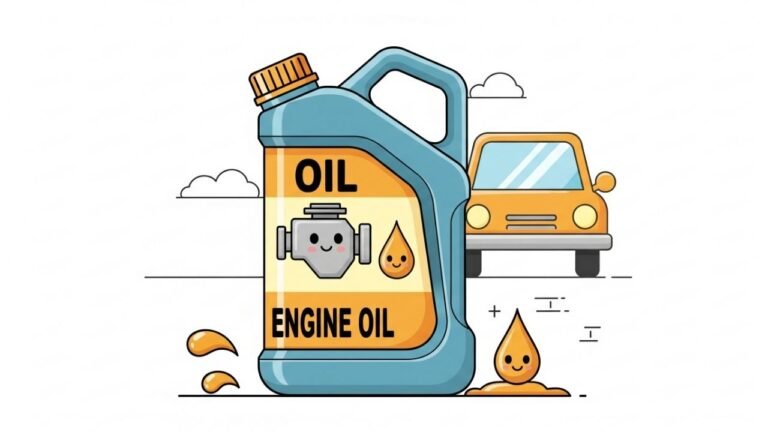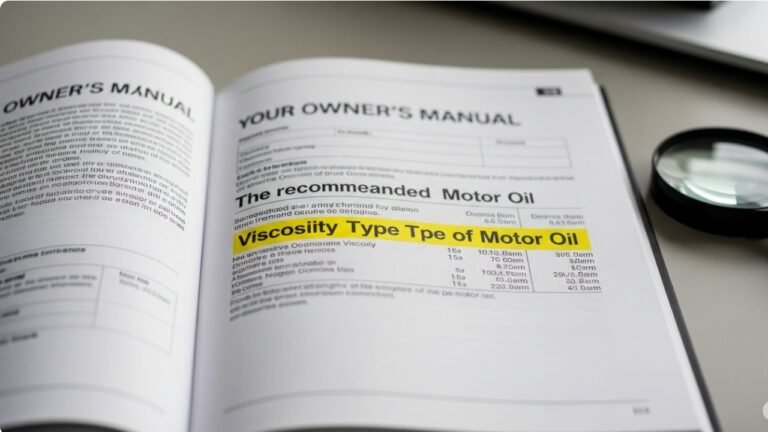Is My Car Leaking Oil or Water?

You pull into your driveway after a smooth ride, park the car, and head inside. A few hours later, you’re back out with a cup of tea, enjoying the afternoon — when suddenly, you spot a dark stain or wet patch under your vehicle. “Wait a minute… is my car leaking oil or water?” That’s the question, isn’t it?
This is one of those small moments that can snowball into bigger stress. Is it serious? Is my engine crying for help? Or is it just innocent condensation? You’re not alone — millions of car owners have stood in your shoes, wondering whether to panic or relax.
In this guide, I’ll walk you through how to tell the difference, what each leak might mean, and what steps you should take. I’ll mix in a few stories from my own driveway detective work and break everything down in plain, friendly language — just like a chat with a good friend over tea.
Oil vs. Water Leak: Why It Matters

Here’s why identifying the leak matters:
-
Oil leaks can signal engine trouble, gasket wear, or dangerous oil loss.
-
Water leaks might be harmless A/C condensation — or a sign of a cracked radiator.
-
Ignoring leaks could mean getting stranded on the highway or worse, causing internal damage to your engine.
Main Keyword Alert: If you’ve been wondering, “is my car leaking oil or water?”, keep reading — we’ll crack the case together.
First Glance: What Does the Leak Look Like?
Before you call a mechanic or panic-search for a tow truck, look under your car. Here’s a helpful comparison table to guide you:
| Feature | Oil Leak | Water Leak |
|---|---|---|
| Color | Dark brown, black, or amber | Clear or slightly dirty |
| Texture | Slick, greasy | Thin, watery |
| Smell | Burnt or motor oil smell | No strong smell (unless it’s coolant) |
| Location | Under engine or near oil pan | Near front (radiator) or under A/C |
| Feel (on finger) | Oily, sticky | Dries quickly, non-greasy |
Quick Tip:
Lay a piece of white cardboard or paper under your car overnight. In the morning, you’ll have a better view of the leak’s color and texture. Like solving a mystery with clues — but for adults who pay for their own car repairs.
Common Signs of an Oil Leak
When I had my first car — an old hand-me-down Toyota — I ignored a tiny dark patch under it for weeks. I thought, “It’s old, it’s probably fine.” Spoiler: it wasn’t. One morning, my car refused to start, and the mechanic said I had low engine oil from a long-ignored leak.
Here’s how to spot an oil leak before it becomes a bigger headache:
-
Dark, greasy patches under the engine area
-
Burning oil smell when the engine is hot
-
Smoke from under the hood
-
Oil warning light on the dashboard
-
Visible oil on the engine or undercarriage
If any of these ring true, you might already know the answer to “is my car leaking oil or water?” — and it’s oil. Time to take action.
What Causes Oil Leaks?
Oil doesn’t just vanish. It escapes — through cracks, loose fittings, or worn parts. Here are some usual suspects:
-
Worn valve cover gaskets
-
Loose or damaged oil filter
-
Cracked oil pan
-
Bad seals or gaskets
-
Over-tightened oil drain plug
When one of these parts fails, oil can drip steadily — leaving a mess and reducing your engine’s lubrication. That’s like a runner trying to finish a marathon without water. Not good.
Common Signs of a Water Leak
Now let’s flip the script. If you see clear liquid under your car, it doesn’t always mean trouble. In fact, it might just be air conditioning condensation, especially on hot or humid days.
But not all water-like leaks are innocent. If the water smells sweet or is tinted green, orange, or pink — you’re probably looking at coolant, not water. And coolant leaks can spell big trouble.
Watch for:
-
Puddles under the front of the car
-
Steam from the radiator or hood
-
Sweet smell near the leak
-
Coolant warning light on the dashboard
-
Overheating engine
In this case, the answer to “is my car leaking oil or water” might actually be: neither — it’s coolant. Surprise twist, right?
How to Tell the Difference (DIY Leak Test)
Still unsure? Let’s roll up our sleeves. Here’s a simple checklist to help you figure out what kind of leak you’re dealing with.
DIY Leak Check:
-
Color Test: Dark and greasy? Likely oil. Clear or lightly colored? Could be water or coolant.
-
Smell Test: Burnt smell = oil. Sweet smell = coolant. No smell = probably water.
-
Touch Test: Rub a drop between fingers. Slick and greasy? Oil. Thin and quick-drying? Water.
-
Location Check: Front passenger side under A/C? Likely condensation. Under engine? Possibly oil.
-
Paper Trick: Place cardboard overnight, mark the spot, check in the morning.
This little detective work could save you hundreds of dollars and give you peace of mind.
Is It Safe to Drive with a Leak?
Here’s the truth: it depends on the type and size of the leak.
-
Small water leak (from A/C) — Safe to drive
-
Coolant leak — Drive only short distances, monitor engine temp
-
Minor oil leak — Maybe okay, but check levels often
-
Large oil or coolant leak — Not safe. Get it checked immediately.
Think of it like this: if your body was leaking fluid, would you go to work or go to a doctor? Your car deserves the same care.
What Should I Do After Spotting a Leak?
So, you’ve checked the puddle. You’ve sniffed it, touched it (ew, I know), and compared it to the checklist. Now what?
Here’s your next move, step by step:
-
Don’t panic — Not every leak means disaster.
-
Check fluid levels — Look at your oil dipstick and coolant reservoir.
-
Take photos — Snap the leak location and the stain itself.
-
Drive only if safe — Short, essential trips only if it’s a coolant or oil leak.
-
Book a mechanic appointment — Whether at home or in a shop, get a professional’s eyes on it.
If you’ve been asking, “is my car leaking oil or water?”, and now you know the answer, you’re already ahead of the game. Many people ignore the signs until it’s too late — but not you.
How to Fix a Car Leak (If You’re a DIY Type)
Some minor leaks can be tackled with a little elbow grease and a can-do attitude. If you enjoy weekend car projects and aren’t afraid of dirty hands, here’s what you can do:
️ For Oil Leaks:
-
Tighten the oil drain plug
-
Replace the oil filter if it looks worn or damaged
-
Use stop-leak additives (temporary solution)
-
Clean around valve cover gaskets, then reseal if leaking
-
Install new gaskets (a bit advanced, but doable)
For Coolant or Water Leaks:
-
Check radiator cap — replace if cracked or loose
-
Inspect hoses for cracks or soft spots — replace if needed
-
Use radiator sealant (temporary fix only)
-
Flush coolant system if it’s old and sludgy
-
Refill coolant to proper levels
Important Note:
Always follow your car’s manual. If you don’t feel confident, don’t risk it — some jobs are best left to the pros. And remember, don’t ever mix up coolant and oil — it’s like mixing up shampoo and superglue. Bad things happen.
When to Call a Mechanic (Don’t Wait Too Long)
Here’s a rule I live by: If you’re not sure, ask someone who is. Mechanics see hundreds of leaks every year. What seems like a mystery to you is a routine fix to them.
Call a mechanic if:
-
You see multiple types of fluid under your car
-
Your car is overheating or running rough
-
You’ve already topped off fluids, but the leak comes back
-
The leak is getting bigger each day
-
You smell burning or sweet odors while driving
Don’t delay. A $60 visit today might save you from a $2,000 engine replacement next month.
Preventive Maintenance: Stop the Leaks Before They Start
Prevention beats repair — every single time. Treat your car like you would your body: with regular check-ups and lots of clean fluids.
Tips to Prevent Leaks:
-
Change oil every 5,000–7,000 miles
-
Check fluid levels monthly
-
Inspect under your car weekly for drips
-
Don’t overfill oil or coolant
-
Use high-quality gaskets and OEM parts
-
Have your radiator flushed every 2–3 years
Think of it like brushing your teeth. You don’t wait until there’s a cavity, right? Your car deserves the same consistency.
Real Story: How I Missed a Leak Once
Let me tell you about the time I ignored a pink puddle under my Nissan. I thought it was just water. Weeks passed. Then one day — boom — my car overheated on the highway. Turns out, it was leaking coolant the whole time, and I didn’t catch it.
The repair? A cracked radiator, $420 out of pocket.
If only I had read an article like this before! Now, I check my driveway like a detective every Sunday morning.
FAQs: Car Leak Questions You Were Afraid to Ask
1. Is it normal to see water under my car?
Yes — especially if it’s hot or humid outside. That’s just condensation from the A/C system. But check the color and smell to be sure it’s not coolant.
2. What color is oil when it leaks?
Fresh oil is amber or light brown. Old oil looks dark brown or black. Either way, it’s slick, greasy, and smells burnt.
3. How do I know if it’s coolant or water?
Coolant often has a bright color (green, orange, pink) and smells sweet. Water is clear and odorless. If in doubt, test it with a paper towel and your nose.
4. Can I drive with a small oil leak?
You can, but it’s not ideal. Monitor oil levels closely and drive only short distances. Get it fixed as soon as you can.
5. Will insurance cover a leaking car?
Usually, no — unless the leak caused damage in an accident or due to a covered event. Most leaks are considered wear-and-tear.
6. Can a coolant leak damage my engine?
Absolutely. If your engine overheats, it can lead to blown gaskets or warped cylinders — both expensive repairs.
7. Is a transmission fluid leak mistaken for oil?
Yes, sometimes. Transmission fluid is reddish and slippery, while motor oil is brown. Location also helps — transmission leaks tend to be near the center or rear of the engine bay.
8. Why is my car leaking oil after an oil change?
A few reasons: the drain plug might not be tight, the filter could be cross-threaded, or there might be spilled oil that hasn’t burned off yet.
Final Thoughts: Trust Your Gut (And Your Driveway)
So, let’s go back to that original question: “is my car leaking oil or water?”
If you’ve made it this far, chances are you now have a solid idea. You’ve learned the signs, checked the stains, sniffed the liquid (yep, it’s weird but effective), and maybe even peered under your hood.
But more than that — you’ve learned to listen to your car. Leaks are like whispers from your engine. If you pay attention, you can fix problems before they roar.
Your driveway has a story to tell. Keep an eye on it, and your car will thank you with miles of smooth, worry-free driving.






